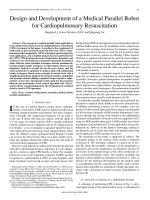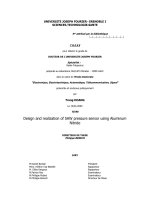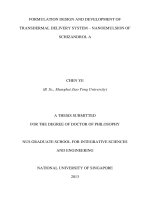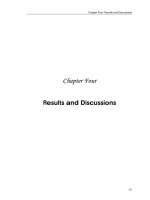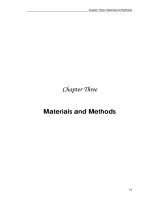Chapter 4 results discussions design and development of tissue engineering scafflods using rapid prototyping technology
Bạn đang xem bản rút gọn của tài liệu. Xem và tải ngay bản đầy đủ của tài liệu tại đây (3.96 MB, 106 trang )
Chapter Four: Results and Discussions
Chapter Four
Results and Discussions
91
Chapter Four: Results and Discussions
4.1 Polymer Synthesis
Ring-opening polymerization (ROP) of ε-caprolactone initiated by dihydroxyl
PEG formed an ABA-type triblock copolymer with a central PEG block and
two lateral PCL blocks. Polymers initiated by ethylene glycol can be regarded
as PCL homopolymer since ethylene glycol is a small molecule. On the other
hand, copolymerization initiated by mPEG propagated at one end only. The
hydrophilic segment in the resulted mPEG-PCL copolymers should exhibit
higher chain mobility as compared to PCL-PEG-PCL. Based on the now well-
known mechanism of ROP of lactonic compounds initiated by alcohols in the
presence of a catalyst like stannous octoate (Kricheldorf et al, 2000; Kowalski
et al, 2000), the process of block copolymerization of ε-caprolactone and DL-
lactide was extended to zinc metal initiation by mPEGOH (Huang et al, 2004).
In a first step, the ROP of ε-caprolactone was initiated by mPEG propagating
at the OH end only to form a diblock PEG-PCL copolymer terminated by an
OH group. This hydroxyl-bearing diblock copolymer was then used as
macroinitiator to polymerize the DL-lactide. The main structure of the chain
was thus PEG-PCL-P(DL)LA.
Table 4.1 summarizes the molecular characteristics of the resulting polymers
and of the precursors involved in the synthesis, namely mPEGOH, PEG-PCL.
In this study, mPEG with a
nM of 5,000, dihydroxyl PEG with a nM of 8,000,
and an initial [CL]/[EO] ratio of 3/1 were selected as a compromise between
the formation of high molecular weights, appropriate PEG content, and the
bioresorbability of PEG-rich degradation products. In fact, low molecular
weight PEG (<30,000 Daltons) can be excreted through kidney filtration
92
Chapter Four: Results and Discussions
(Cerrai et al, 1994; Harris, 1992). For PCL homopolymer, a [CL]/[EG] molar
ratio of 700/1 was used. It is worth noting that commercial mPEGOH generally
contains PEG-diOH in small amounts. Therefore, it is likely that the PEG-PCL-
P(DL)LA triblock copolymers was complemented by a small amount of
P(DL)LA-PCL-PEG-PCL-P(DL)LA pentablock copolymer that could not be
separated from the triblock copolymer nor assessed because of structural
similarity. The presence of this compound was thus considered as negligible.
Table 4.1: Molecular characteristics of PCL, PCL/PEG and PEG-PCL-
P(DL)LA block copolymers, and their precursors
Feed Product
a)
Acronym Initiator
LA/CL/EO
LA/CL/EO
nM
b)
Lp=
nMw/M
b)
Yield (%)
PCL EG 0/700/1 - 50,000 1.7 90
mPEG-PCL mPEG5000 0/3/1 0/3.9/1 33,000 1.6 85
PCL-PEG-PCL PEG8000 0/3/1 0/3.7/1 30,000 1.8 90
mPEG-PCL-PLA
c)
mPEG-PCL 6.3 /4.0/1 7.3 /5.2/1 41,000 1.4
80
a)
determined by
1
H NMR spectra
b)
obtained by SEC with respect to polystyrene standards from polysciences
c)
recovered after dialysis
The [LA]/[CL]/[EO] ratio was also determined by 1HNMR from the integrations
of the from the integrations of the 1HNMR signals due to PLA blocks at 5.1
ppm (CH), to PCL blocks at 4.0 ppm (O-CH2-) and to PEG blocks at 3.6 ppm
(O-CH2-). The molecular weight and the [LA]/[CL]/[EO] molar ratio of the
93
Chapter Four: Results and Discussions
resulted polymers can be tailored by the feed composition. The [CL]/[EO]
molar ratio of the copolymers was higher than that of the feed. This finding
was assigned to the fact that unreacted PEG or PEG-rich species were
removed during purification.
According to literatures (Feng et al, 1983; Deng et al, 1997), polymerization
of DL-lactide initiated by PEG-PCL-OH yields copolymers with broad
molecular weight distributions. Therefore, careful purification was performed
to eliminate low molecular weight species, especially at the stage of the
triblock copolymer. Higher [CL]/[EO] and lower [LA]/[CL] molar ratios were
obtained when the crude PEG-PCL-P(DL)LA was washed with cold acetone
(<10°C). The number average degree of polymerization (
nDP
) and the
number average molecular weight
nM were estimated using the following
equations:
PEG
DPn
= (
PEG
nM
/ 44)
PCL
nDP
= (
PEG
nM
/ 44) x ([CL] / [EO])
PLA
DPn
= (
PEG
nM
/ 44) x ([LA] / [EO])
nM =
PEG
nM
+ 114
PCL
DP
where, 44 and 114 are the molecular weights of EO and CL repeat units,
respectively. The
nM
values calculated from SEC relative to polystyrene
standards were lower than those deduced from the 1HNMR spectra.
94
Chapter Four: Results and Discussions
4.2 Thermal Characterization
The thermal properties of mPEGOH, PEG-PCL and PEG-PCL-P(DL)LA
polymers were investigated by DSC and TGA. All the polymers appeared
semicrystalline with a single melting peak in DSC thermograms. The ∆H
m
value of mPEGOH was 181 J/g, i.e. much higher than that of PEG-PCL (54
J/g) and PEG-PCL-P(DL)LA (43 J/g). The latter had the lowest ∆H
m
value due
to the presence of amorphous P(DL)LA blocks. mPEGOH and PEG-PCL
melted at Tm ~ 65°C. It is worth noting that PEG and PCL homopolymers
exhibit close melting temperatures, i.e. ~ 65°C (Li and Vert, 2003; Li et al,
2002). PEG-PCL-P(DL)LA showed a similar thermogram but with a slightly
lower T
m
value. Insofar as thermal stability was concerned, mPEGOH and
PEG-PCL exhibited similar simple TGA thermograms. In contrast, a two-step
thermal degradation was observed in the case of PEG-PCL-P(DL)LA (Huang
et al, 2003). T
d
temperatures read at 5% weight loss were 240°C for
mPEGOH, 320°C for PEG-PCL and 300°C for PEG-PCL-PLA. Therefore,
PEG appeared stabilized by the presence of the PCL segment, a trend that
was attenuated after polymerization with DL-lactide. From the rapid
prototyping viewpoint, the diblock and the triblock copolymers offered a wide
range of temperatures for practical thermal processing.
The X-ray diffraction pattern of mPEGOH exhibited two main peaks at θ = 9.4°
and 11.5°. The copolymers exhibited patterns typical of the crystalline
structure of PCL, namely an intense peak at θ = 10.6° and a smaller one at
11.8° (Huang et al, 2003). The diffraction peaks that are characteristic of PEG
95
Chapter Four: Results and Discussions
were not detected in the spectra of the copolymers, thus indicating that PEG
blocks were unable to crystallize.
The thermal and molecular properties of the polymers determined via DSC
and GPC analyses before and after processing into scaffolds are presented in
Figure 4.1 and Table 4.2. Polymers being of semi-crystalline nature showed
well-defined melting profiles.
15
20
25
30
35
40
45
0 50 100 150
Temperature (oC)
Heat Flow
PCL-PEG-PCL PEG-PCL-PLA
PCL-PEG PCL
15
20
25
30
35
40
0 50 100 150
Temperature (oC)
Heat Flow
PCL-PEG-PCL PEG-PCL-PLA
PCL-PEG PCL
Figure 4.1: Thermal responses of the polymers before and after processing; (a):
polymers before processing into scaffolds, (b): polymers after processing
All polymer samples melted in the temperature range of 65
°C
to 70
°C
and
found to be completely molten above 70
°C
. Potential degradation of polymers
due to melt extrusion process was characterized by measuring the molecular
weights. The filament extrusion process did not result in a significant change
of the molecular weight. The crystallinity fraction of polymers was also not
observed to alter significantly when the polymers were processed into
scaffolds. The crystallinity values ranged between 22% and 44%. The shear
forces on the polymer melt during the filament extrusion did not cause the
percentage of crystallinity to change significantly. The thermal analyses
96
Chapter Four: Results and Discussions
results demonstrate the favorable rheological properties of the polymers in
molten state and their thermal stability to build scaffolds utilizing melt
extrusion technique.
Table 4.2: Molecular weight distribution and DSC results of the different samples
Samples Tm (
0
CMn Ip=Mw/Mn
Melting Enthalpy
Hm (J/g)
Crystallinity (%)
PCL Raw 63.2 50000 1.7 56 40.14
PCL Scaffold 64.3 51500 1.6 55.3 39.64
PCL-PEG Raw 63.5 33000 1.6 62 44.44
PCL-PEG Scaffold 65.3 33600 1.7 61.8 44.30
PCL-PEG-PCL Raw 64.4 30000 1.8 48 34.41
PCL-PEG-PCL Scaffold 65.6 31700 1.7 47.2 33.84
PEG-PCL-PLA Raw 62.5 41000 1.4 32 22.94
PEG-PCL-PLA Scaffold 63.1 42400 1.4 31.5 22.58
H
m
° is the melting enthalpy of 100% crystalline PCL (139.5 J/g) (Pitt et al, 1981)
The various copolymers conserved the excellent thermal behavior inherent to
PCL, thus providing a wide processing window for scaffold fabrication.
Besides, the presence of PPLA and PEG moiety, and the resulted low
crystallinity should improve the biocompatibility and biodegradability of the
materials.
4.3 Surface Wetability
Water contact angle measurement was performed on the solid flat surfaces of
four different polymers (PCL, PCL-PEG, PCL-PEG-PCL & PEL-PCL-PLA) to
determine the hydrophilicity of the scaffolds. The contact angles on four
97
Chapter Four: Results and Discussions
polymer surfaces were found to be in the range of 40° to 90° as shown in
Table 4.3, which are moderately but statistically different. PCL surface
showed highest contact angle (90° ±2) that indicates most hydrophobic. On
the other hand, PCL-PEG-PCL triblock resulted in lowest contact angle
(40°±1.0), which corresponds to most hydrophilic.
Table 4.3: Contact angle values on different polymer surfaces
SL No Solid Surface Contact Angle (degree)
1 PCL 90±2.0
4 PEG-PCL-PLA 70±2.0
2 PCL-PEG 50±1.5
3 PCL-PEG-PCL 40±1.0
The statistical difference in contact angle suggests that the incorporation of
hydrophilic PEG into hydrophobic PCL results in changes of overall
hydrophilicity or surface wetability of the multiblock copolymers. It has also
been observed by Li et al (1998) that incorporation of PEG improves the
hydrophilicity of the multiblock copolymers with respect to PCL homopolymer.
From thermodynamic point of view, the contact arises from the consideration
of a
thermodynamic equilibrium between three phases as presented by Figure
4.2: the
liquid phase of the droplet (L), the solid phase of the substrate (S),
and the gas phase of the ambient (G). At equilibrium, the summation of the
interfacial energies is zero which can be written as
Young-Dupré equation:
0= γ
SG
– γ
SL
– γ
LG
cosθ (4.1)
98
Chapter Four: Results and Discussions
where, the symbols γ
SG,
γ
SL,
γ
LG
and θ are denoted as the solid-vapor
interfacial energy, solid-liquid interfacial energy, the liquid-vapor energy (i.e.
the surface tension, γ) and the experimental contact angle, respectively.
γ
LG
γ
SG
θ
C
γ
SL
Figure 4.2: Thermodynamic equilibrium among three phases producing water
contact angle on solid surface
The equation (4.1) can be rewritten as:
Y(1+cos θ) = ∆W
SLG
(4.2)
Where, ∆W
SLG
is the adhesion energy per unit area of the solid and liquid
surfaces when in the medium V.
According to equation (4.2), with the decrease of the value of θ, the adhesion
energy, in turn the surface wetability increases.
Surface wetability of polymer substrates has been shown to strongly influence
cell adhesion. The hydrophilic substrates promote adhesion of cells, whereas
hydrophobic substrates do not (Schakenraad et al, 1986). The changes in
hydrophilicity influence cellular function by affecting the deposition of
biochemical moieties on the surface. For instance, changes in hydrophilicity
99
Chapter Four: Results and Discussions
could potentially influence the adsorption and folding of proteins on the
surface, which would affect cellular attachment and function subsequently.
This phenomenon could be interpreted in terms of free energy of adhesion
(Schakenraad et al, 1986; Altankov et al, 1997; Andreas et al, 1996). Several
research groups have shown that the materials with low surface energies
result in low cell attachment (Baier et al, 1984; Vand der Valk et al, 1983).
Grinell (1978) has also reported that surface wetability influces adhesion and
proliferation of different types of mammalian cells. Therefore, the substratum
free surface energy plays an important role in cell attachment and
proliferation. However, too much increase in surface hydrophilicity may also
reduce cell attachment and consequently cell proliferation (Lampin et al,
1997).
The water contact angle can be affected by several factors. One of them is
the surface roughness. If the surface is composed of numerous holes or
pores, the liquid would penetrate and fill up most of the holes and pores,
hence lowering the water contact angle. Another factor that affects the water
contact angle is the processing procedure of the solid surface. Substrate that
has crystallized in contact with water has a lower contact angle than that
which has crystallized in air. It is due to the orientation of water-attracting
groups outwards when the substrate is crystallized in contact with water.
The water contact angle is an indicator of free surface energy and depicts the
wetability of the material surface. The smaller the water contact angle, the
higher is the surface free energy and the more reactive is the surface.
100
Chapter Four: Results and Discussions
However, one limitation of this study was that the contact angle was
measured only on two-dimensional flat surfaces instead of 3D scaffolds.
Nevertheless, the results were considered to be relevant because the solid
surfaces for wetability tests were prepared via same melt extrusion process
as scaffolds. Contact angle measurements on the 3D scaffold structures were
attempted, but the results were not reproducible due to the presence of rough
and porous surfaces.
PCL exhibits desirable characteristics for the biomedical applications,
including biodegradability, biocompatibility, commercial availability and
affordability, especially as scaffolds and drug delivery devices (Lu et al.,
20020. PCL scaffolds have demonstrated positive cell compatibility interaction
with cells (e.g. bone cells), to promote their attachment and proliferation, and
minimal osteoconduction, the ingrowth of capillaries and cells from the host
into the scaffold structure to form bone (Schantz et al, 2003). However,
polyesters differing in their chemical composition, molecular weight,
polydispersity, crystallinity and thermal transitions would result in scaffolds
varying hydrophilicity, degree of osteoconduction and different absorption
rates. Hence, the main aim of the incorporation of other polymer components
into the PCL main chain was to modulate the mechanical properties and
resorption rates of the original PCL scaffold.
4.4 Scaffold Design and Processing
The requirements for tissue engineering scaffolds like, morphological,
mechanical and biochemical properties are application specific i.e. different
101
Chapter Four: Results and Discussions
targeted applications have different requirements. These requirements can be
fulfilled by the novel combination of synthetic biopolymers and rapid
prototyping technology. Based on this hypothesis, PCL homopolymer and
three PCL-based copolymers namely, PCL-PEG diblock copolymer, PCL-
PEG-PCL and PEG-PCL-PLA triblock copolymers were investigated to
develop 3D scaffold family using the DRBRP system to cater a wide range of
tissue engineering applications. Initially, all four polymers were experimented
to investigate the feasibility of these polymers to be processed into 3D
scaffolds by melt extrusion system and the efficacy of the DRBRP technique
to accommodate a wide range of scaffold materials.
The 3D scaffold structure designed and fabricated using DRBRP system was
highly similar to the honeycomb of a bee (Gibson and Ashby, 1997), with its
regular array of identical pores, when viewed in the Z-direction of the
fabrication process (Figure 3.3). The basic difference lies in the shape of the
pores: the bee’s honeycomb comprises of hexagonal pores surrounded by
solid faces which nest together to fill a plane, but the DRBRP scaffold
structure was built from neatly-aligned filaments stacked in horizontal layers
and comprised of pores surrounded by solid struts.
Three distinctive honeycomb-like scaffold architectures were designed in this
study by applying three lay-own patterns (0/90°, 0/60° and 0/30°). The pattern
0/90° resulted in square pores, 0/60° pattern produced triangular pores,
whereas the 0/30° pattern formed complex polygonal pores (Figure 3.4). All
the patterns were directly designed in the RPBOD scaffold model where the
102
Chapter Four: Results and Discussions
deposition paths were first created on computer. More complex lay-down
patterns could also be designed using the RPBOD software to produce
diverse pore shapes.
When the scaffolds were observed from the cross-sectional view i.e. in X- or
Y-direction of the fabrication process there revealed a pore network with fully
interconnected channels of high regularity as schematically demonstrated by
Figure 3.5. Hence, the DRBRP scaffold had not only honeycomb-like
architecture but also the structure of an open-pore foam with the pores
interconnecting through adjacent faces.
4.5 Morphological Characterization
4.5.1 Processing Various Polymers
One of the major challenges in the design of tissue engineering scaffold is to
mimic the structure and biological functions of the natural extracellular matrix
(ECM). Essentially, the scaffolds should be three-dimensional and highly
porous with an interconnected pore network to favour flow transport of
nutrients and metabolic waste as well as tissue integration and
vascularization. It was observed that a highly interconnected channel network
in the scaffold was essential for flow transport of nutrients and wastes in vivo
(Thomson et al, 1995b; Cohen et al, 1993). The micro-structural formability
and internal morphology of as-fabricated scaffolds i.e. the homogeneity of the
deposited filaments and the regularity of the pore space between them were
evaluated by the scanning electron microscope (SEM) JSM-5800LV (JEOL USA,
Peabody, MA). The gold-coated scaffold samples were observed both from plan and
103
Chapter Four: Results and Discussions
cross-sectional views under SEM operated under high vacuum at an accelerating
voltage of 15kV and a current of 60-90 mA. The plan-view reveals the lay-down
pattern of the filaments deposited during processing while the side-view shows the
layers of filaments stacked above each other.
All the SEM images (Figure 4.3) of the scaffolds fabricated with four polymers (PCL,
PCL-PEG, PCL-PEG-PLC and PEG-PCL-PLA) demonstrated the homogeneity and
consistency of the deposited microfilaments with very neat spatial arrangement of
pores and channels when viewed in the Z-direction of the fabrication process (top
row). The 0/90° lay-down pattern resulted in square pores coherent to the designs
(Figure 3.4), which were highly regular and reproducible. The x-sectional views of the
SEM images revealed the complete interconnectivity and integrity of the pore
networks that indicated the feasibility of processing four polymers into 3-D porous
scaffolds. It was also observed that the filaments fused evenly at the junctions that
prevented interlayer delamination.
(a) PCL (b) PCL-PEG (c) PCL-PEG-PCL (c) PEG-PCL-PLA
Figure 4.3: SEM images of scaffolds fabricated with 4 polymers (Nozzle Size:
500 µm & FD: 1.5 mm); top row: plan view & bottom row: x-sectional view
104
Chapter Four: Results and Discussions
This phenomenon evidenced the suitability of the polymers’ rheological
properties for melt extrusion and the efficacy of the DRBRP technique to
process these polymers into 3D scaffolds with honeycomb like structures. The
reproducibility and regularity of the scaffold’s pore networks were found to be
consistent and similar to that fabricated by some other techniques like, FDM
(Zein et al, 2002), 3DF deposition (Woodfield et al, 2004) and PED (Wang et
al, 2004) system. However, the homogeneity and consistency of the
deposited microfilaments, and consequently the scaffold morphology and
integrity might be influenced by the process parameters (liquefier temperature
T
L
, extrusion pressure P
E
and deposition speed S
D
) that are discussed in the
proceeding section.
4.5.2 Influence of Process Parameters
In this investigation, the scaffolds were fabricated with a single lay-down
pattern of 0/90˚ using two polymers (PCL and PCL-PEG) and employing a
range of process parameters (TL, PE and SD). To investigate the effect of
process parameters, simpler shapes other than scaffolds would work.
However, to test the process variations in actual situation the scaffold
samples were made instead of simpler shapes. The experimental
investigations revealed that the liquefier temperature, extrusion pressure and
deposition speed had direct influence on the material flow that was
manifested by the change in filament diameter (RW) and consequently the
morphological characteristics as presented by Figures 4.4 – 4.9. The SEM
images were utilized to measure the filament diameters or road widths (RW)
and pore sizes while the porosities were determined by ultrapycnometer and
105
Chapter Four: Results and Discussions
micro-CT methods. The pore dimensions in different directions of fabrication
process are not essentially the same. In the x- or y- direction, the pore width is
formed in-between the intercrossing of filaments and hence is defined by the
deference between FD and RW. Likewise, the pore height in the z direction is
formed from void produced by the stacking of filament layers, and thus their
size is regulated by the layer gap (LG) (Figure 3.5). SEM analysis and
porosity measurement reveals that the changes in process parameters
significantly changed the RW and consequently the overall scaffolds’ porous
characteristics. The changes in process parameters also corresponded to the
changes in surface to volume ratio accordingly. The porous characteristics
(RW, pore size and porosity) of the scaffolds fabricated from two polymers
(PCL & PCL-PEG) differed a very little under same conditions. Likewise, there
was only a small difference between the porosity values measured by
ultrapycnometer and micro-CT methods. Therefore, for simplicity the porous
characteristics refer to that of PCL-PEG scaffold, and the porosities refer to
the values measured by micro-CT method throughout the text unless
mentioned otherwise.
Liquefier Temperature: The increase in liquefier temperature resulted in
increase of RW and thus decreased the pore size and porosity (Table 4.4) at
a specific extruding pressure and deposition speed. It is because of the fact
that the fluidity of polymer melt increases with increasing temperature that
makes faster and more dispensing of the polymer. The overall morphological
changes due to change of liquefier temperature are presented in Table 4.4.
An increase of temperature from 80 to 100°C resulted in an increase of road
106
Chapter Four: Results and Discussions
width (RW) from 375±45 to 620±45 µm, which corresponded to a decrease of
pore width in x- or y-direction from 1125±90 to 880±90 µm, pore height in z-
direction from 330±38 to 120±20 µm and porosity from 72 to 48 %,
respectively.
Table 4.4: Morphological changes due to change of liquefier temperature
while extrusion pressure and deposition speed remained fixed at 4.0 bars and
300 mm/min, respectively
Temperature
(°C)
RW
(µm)
Pore
Width
(µm)
Pore
Height
(µm)
Porosity
(%)
S/V Ratio
(mm
2
/mm
3
)
Inter-
Connectivity
(%)
80 375±45 1125±90 330±38 72 12.10 100
90 500±25 1000±50 230±30 65 10.92 100
100 620±45 880±90 120±20 48 8.07 100
T1 = 80°C T2 = 90°C T3 = 100°C
Figure 4.4: SEM images of PCL scaffolds demonstrating the influence of
temperature on their morphologies (nozzle size: 500 µm & FD: 1.5 mm); top
row: plan view & bottom row: x-sectional view
107
Chapter Four: Results and Discussions
T1 = 80°C T2 = 90°C T3 = 100°C
Figure 4.5: SEM images of PCL-PEG scaffolds demonstrating the influence of
temperature on their morphologies (nozzle size: 500 µm & FD: 1.5 mm); top
row: plan view & bottom row: x-sectional view
Extrusion Pressure: Similar to liquefier temperature, increase of
extrusion pressure caused the increase of RW and thus decreased the pore
size and porosity (Table 4.5) at a given condition of temperature and speed.
An increase of pressure from 3 to 5 bars followed by an increase of RW from
380±50 to 623±45 µm, which accorded with a decrease of pore width from
1120±100 to 877±90 µm, pore height from 325±35 to 118±18 µm and
consequently, porosity from 73 to 47 %. In this case, the increase in pressure
resulted in a higher polymer flow per travel distance, which resulted in the
larger fiber diameter and led to the decrease in porosity.
108
Chapter Four: Results and Discussions
Table 4.5: Morphological changes due to change of extrusion pressure while
liquefier temperature and deposition speed remained fixed at 90°C and
300mm/min, respectively
Pressure
(bars)
RW
(µm)
Pore Width
(µm)
Pore Height
(µm)
Porosity
(%)
S/V Ratio
(mm
2
/mm
3
)
Inter-
Connectivity
(%)
3.0 380±50 1120±100 325±35 73 12.27 100
4.0 500±25 1000±50 230±30 66 11.09 100
5.0 623±45 877±90 118±18 47 7.90 100
P1=3.0 bars P2=4.0 bars P3=5.0 bars
Figure 4.6: SEM images of PCL scaffolds demonstrating the influence of
extrusion pressure on their morphologies (nozzle size: 500 µm & FD: 1.5
mm); top row: plan view & bottom row: x-sectional view
109
Chapter Four: Results and Discussions
P1=3.0 bars P2=4.0 bars P3=5.0 bars
Figure 4.7: SEM images of PCL-PEG scaffolds demonstrating the influence of
extrusion pressure on their morphologies (nozzle size: 500 µm & FD: 1.5
mm); top row: plan view & bottom row: x-sectional view
Deposition Speed: Unlike liquefier temperature and extrusion pressure,
increasing deposition speed resulted in a smaller polymer flow per travel
distance that resulted in a decrease in RW and, hence increase in pore size
and porosity. In such case, the polymer melt comes out at a specific flow rate
under certain conditions whereas, the nozzle drugs the melt at a faster rate,
A1S1=A2S2 (4.3)
where, A is the area of polymer melt that in tern, equivalent to the filament
diameter and S is the deposition speed.
If S increases the filament diameter must decrease to maintain specific flow
rate. With the increase of speed from 240 to 360 mm/min caused a decrease
in RW from 615±40 to 377±48 µm that accordingly, increased the pore width
110
Chapter Four: Results and Discussions
from 885±80 to 1123±100 µm, pore height from 125±22 to 340±30 µm and
porosity from 45 to 75 %, respectively as reported in Table 4.6.
Table 4.6: Morphological changes due to change of deposition speed while
liquefier temperature and extrusion pressure remained fixed at 90°C and 4.0
bars, respectively
Speed
(mm/min)
RW
(µm)
Pore Width
(µm)
Pore Height
(µm)
Porosity
(%)
S/V Ratio
(mm
2
/mm
3
)
Inter-
Connectivity
(%)
240 615±40 885±80 125±22 45 7.56 100
300 500±25 1000±50 230±30 66 11.09 100
360 377±48 1123±100 340±30 75 12.60 100
S=240 mm/min S=300 mm/min S=360 mm/min
Figure 4.8: SEM images of PCL scaffolds demonstrating the influence of
deposition speed on their morphologies (nozzle size: 500 µm & FD: 1.5 mm);
top row: plan view & bottom row: x-sectional view
111
Chapter Four: Results and Discussions
S=240 mm/min S=300 mm/min S=360 mm/min
Figure 4.9: SEM images of PCL-PEG scaffolds demonstrating the influence of
deposition speed on their morphologies (nozzle size: 500 µm & FD: 1.5 mm);
top row: plan view & bottom row: x-sectional view
The overall relationships between the process parameters and scaffold’s
porous characteristics are presented graphically in Figures 4.10 – 4.12. The
graphs demonstrate that the liquefier temperature and extrusion pressure
affect in the similar manner i.e. with the increase of temperature or pressure
the RW increases and consequently, the porosity decreases. On the contrary,
with the increase of deposition speed the RW decreases and thus the porosity
increases. This presentation would assist to obtain the scaffold structure with
desired porous characteristics.
112
Chapter Four: Results and Discussions
300
400
500
600
700
75 80 85 90 95 100 105
Temperature (oC)
RW (um)
40
50
60
70
80
Porosity (%)
RW Porosity
Figure 4.10: Influence of liquefier temperature on RW and porosity of the
scaffolds fabricated with lay-down pattern of 0/90 and nozzle size of 500 µm
300
400
500
600
700
2.533.544.555.5
Pressure (bar)
RW (um)
40
50
60
70
80
90
Porosity
RW Porosity
Figure 4.11: Influence of extrusion pressure on RW and porosity of the
scaffolds fabricated with lay-down pattern of 0/90 and nozzle size of 500 µm
113
Chapter Four: Results and Discussions
300
400
500
600
700
220 270 320 370
Deposition Speed (mm/min)
Filament Dia (um)
40
50
60
70
80
Porosity (%)
RW Porosity
Figure 4.12: Influence of deposition speed on RW and porosity of the
scaffolds fabricated with lay-down pattern of 0/90 and nozzle size of 500 µm
Mariani et al (2006) investigated the influence of process parameters
(deposition velocity and extrusion pressure) on the line width (filament
diameter) of the polymeric scaffolds fabricated with four different polymers—
PCL, PLLA, PLGA, and a blend of PCL and PLLA via pressure-activated
microsyringe (PAM) technique. They produced different line width by varying
the deposition velocity while the extrusion pressure was fixed and vice-versa.
The line width for each polymer was plotted as a function of pressure and
velocity, respectively. The line width increased linearly with increasing
pressure and decreased with increasing velocity. The same phenomenon was
predicted by the model developed by Mironov et al (2003). Moroni et al (2006)
also varied the deposition speed between 100 and 300 mm/min in order to
assess its influence on fiber diameter and overall porosity of the scaffolds.
They observed that a decrease of deposition speed from 300 to 100 mm/min
resulted in an increase of the fiber diameter from 268±32 µm to 432±40 µm,
114
Chapter Four: Results and Discussions
which corresponded to a decrease of the scaffold’s porosity from 75%±6% to
29%±13%.
In case of selecting the best combination of the process parameters, some
factors need to be considered. For example, if the temperature is too low the
polymer melt becomes too viscous to be dispensed out and thus requires
increased pressure, which might impair the whole system. In addition, at low
temperature there might be inadequate fusion (i.e. bonding) at the filament
junctions that may cause delamination of the layers and irregularity in
structure because of insufficient superheat in the polymer melt. On the other
hand, if the temperature is set too high there will be excessive superheat in
the polymer melt that would interrupt the structural formability by
merging/spreading the filaments during solidification as shown in Figure 4.10.
Therefore, the pore size especially pore height will significantly decrease and
as a result the channel interconnectivity will be interrupted or even lost. In
addition, the polymer property might degrade even the hardware accessories
(e.g. plastic tubing etc.) may be fused/burnt off. Likewise, the insufficient
pressure and/or inappropriate dispensing speed might cause irregularity in
filament deposition and ultimately the structural integrity will be lost.
Entrapped air-bubbles (if any) might be another problem in generating
consistent filaments because they interrupt the continuity of polymer flow. To
overcome this, the polymer melt should be held at liquefier temperature for
some while to provide the opportunity for the air-bubbles to be escaped. To
determine the best-suited values of the process parameters for a given nozzle
diameter (e.g. 500 µm), it was targeted to achieve raster RW equivalent to
115



